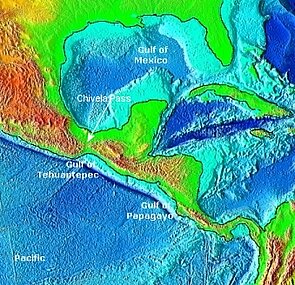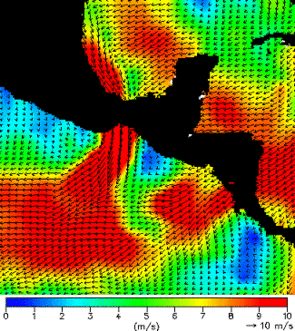Tehuantepec eddies
Image of the month - June 2006


Topography of the Tehuantepec area (left), and winds both sides of the isthmus, as measured by scatterometers (right). Winds from the Gulf of Mexico cross the isthmus through the Chivela Pass, narrow and much lower than the surroundings, thus creating a jet wind. (Credits Noaa (topography) and Coaps (wind map))
In winter, winds blow by pulses through a mountain pass across the Tehuantepec Isthmus (Mexico) to fan out over the Mexican Pacific in the center of the Gulf of Tehuantepec, generating large mesoscale eddies. In situ observations reveal strong cooling of the ocean below the axis of the wind, accompanied by the development of an offshore current jet that quickly evolves into a large anticyclonic eddy.
Altimetry measurements, confirmed by drifter observations, show that these eddies propagate offshore at about 9 km per day, initially southwestward and later more westward. Their sea-level signature can be tracked as far as 140ºW before it disappears during the summer (the eddy season begins in late October and lasts approximately 250 days until early July), coinciding with the strengthening of the North Equatorial Countercurrent. More than twelve years of altimetry data show that five to six eddies are generated on average off the Gulfs of Tehuantepec, Mexico and Papagayo (Nicaragua) each year, and form a band of mesoscale activity between 10 and 12°N extending from 120°W to the coast.
Such ocean features have a large-scale impact on the Eastern Pacific. Altimetry, among other techniques, enable to better know such phenomena, and better understand them.
Sea Level anomalies on February 23, 1994. A series of anticyclonic ("warm") eddies propagating westwards is visible. Those "Tehuantepec eddies" can bring biological material far from the shores. See the animation of SLA over 12 years of altimetry data (mov, 10 MB) (Credits Noaa)
See also:
- Image of the Month, June 1999: An eddy blown by the wind
- Applications: Ocean mesoscale circulation
Websites on this subject:
- Satellite Observations of the Wind Jets off Central America (Coaps, College of Oceanic and Atmospheric Sciences, Oregon State University)
References:
- Thanks to Dr. A. Trasviña (Cicese, Mexico) for inputs and rereading
- See annotated references (pdf, 9 KB)
- Palacios D. M., S. J. Bograd (2005). A census of Tehuantepec and Papagayo eddies in the northeastern tropical Pacific. Geophys. Res. Lett., 32, L23606, doi:10.1029/2005GL024324.





